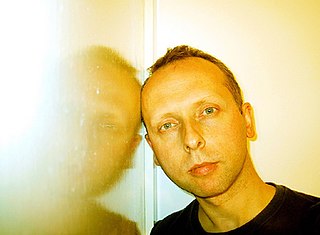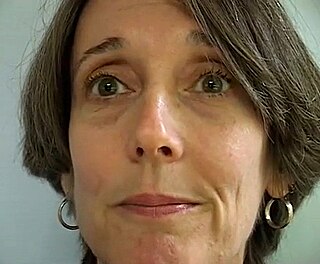Andrew Deutsch (born 1968) is a sound artist who also teaches at the New York State College of Ceramics at Alfred University.
Andrew Deutsch (born 1968) is a sound artist who also teaches at the New York State College of Ceramics at Alfred University.
Deutsch was born in Keene, NH, and received his BFA in Video Art and Printmaking from Alfred University in 1990. He obtained his MFA in Integrated Electronic Art from Rensselaer Polytechnic Institute in 1994. Since 1998 Deutsch has released over 14 CDRs of solo electronic music on his Magic If Recordings label. Each Magic If edition showcases his experimental music and graphic art and is distributed exclusively in the United States by Anomalous Records.
He has collaborated with various artists, including: Harald Bode (posthumously), [1] Tetsu Inoue, Pauline Oliveros, Ann Hamilton, Joseph Nechvatal, Tony Conrad and Stephen Vitiello. His collaborative piece Empty Words 4 with John Cage and Yvar Mikshoff has been accepted into the limited archives of the John Cage Trust. There are re-mixes of Deutsch's CD Garden Music on Oval’s OvalProcess, and Microstoria’s Improvisers.
In 1998 Deutsch formed Carrier Band with Peer Bode and Pauline Oliveros, producing the recordings Carrier and Automatic Inscription of Speech Melody. Deutsch is also a regular collaborator with Peer Bode and Jessie Shefrin on both sound and video projects. Deutsch is the recipient of an Artists Fellowship in Video Art (1997) from the New York Foundation for the Arts and a Special Opportunity Stipend from the New York Foundation for the Arts (1999). [2]
Deutsch has also made video work at the Experimental Television Center in Owego, NY. Deutsch's The Sun was listed as "best of 2005 in music" by Artforum Magazine. He has audio work released by Anomalous Records, Institute for Electronic Arts, and Deep Listening, all of which can be found at Forced Exposure. [3]
Deutsch is a member of the Institute for Electronic Art at Alfred University and the Pauline Oliveros Foundation Board of Advisors. Deutsch is a former member of the Pauline Oliveros Foundation Board of Directors (1999 - 2001).
Since 2010 Deutsch has produced 3 hours of sound/video works with Keith Rowe, CDs with Yuya Ota, Stephen Vitiello, Emil Schult of Kraftwerk, Don Metz and Rebekkah Palov. His video collaborations include "Yu are the Magic" at City Place - Culture Lab, Palm Beach Florida, The Everson Museum, Syracuse New York, and the Burchfield Penny Art Center. He created electronic music and video projections for Ed Sanders' opera Cassandra.

Terrence Mitchell "Terry" Riley is an American composer and performing musician best known as a pioneer of the minimalist school of composition. Influenced by jazz and Indian classical music, his work became notable for its innovative use of repetition, tape music techniques, improvisation, and delay systems. His best known works are the 1964 composition In C and the 1969 album A Rainbow in Curved Air, both considered landmarks of minimalism and important influences on experimental music, rock, and contemporary electronic music. Subsequent works such as Shri Camel (1980) explored just intonation.

Ambient music is a genre of music that emphasizes tone and atmosphere over traditional musical structure or rhythm. It is often "peaceful" sounding and lacks composition, beat, and/or structured melody. It uses textural layers of sound that can reward both passive and active listening and encourage a sense of calm or contemplation. The genre is said to evoke an "atmospheric", "visual", or "unobtrusive" quality. Nature soundscapes may be included, and the sounds of acoustic instruments such as the piano, strings and flute may be emulated through a synthesizer.

In electronics, ring modulation is a signal processing function, an implementation of frequency mixing, in which two signals are combined to yield an output signal. One signal, called the carrier, is typically a sine wave or another simple waveform; the other signal is typically more complicated and is called the input or the modulator signal. A ring modulator is an electronic device for ring modulation. A ring modulator may be used in music synthesizers and as an effects unit.

Pauline Oliveros was an American composer, accordionist and a central figure in the development of post-war experimental and electronic music.
Joan Linda La Barbara is an American vocalist and composer known for her explorations of non-conventional or "extended" vocal techniques. Considered to be a vocal virtuoso in the field of contemporary music, she is credited with advancing a new vocabulary of vocal sounds including trills, whispers, cries, sighs, inhaled tones, and multiphonics.
Electroacoustic music is a genre of popular and Western art music in which composers use technology to manipulate the timbres of acoustic sounds, sometimes by using audio signal processing, such as reverb or harmonizing, on acoustical instruments. It originated around the middle of the 20th century, following the incorporation of electric sound production into compositional practice. The initial developments in electroacoustic music composition to fixed media during the 20th century are associated with the activities of the Groupe de recherches musicales at the ORTF in Paris, the home of musique concrète, the Studio for Electronic Music in Cologne, where the focus was on the composition of elektronische Musik, and the Columbia-Princeton Electronic Music Center in New York City, where tape music, electronic music, and computer music were all explored. Practical electronic music instruments began to appear in the early 20th century.

Stuart Dempster is a trombonist, didjeridu player, improviser, and composer.

Chaim Moshe Tzadik Palestine, known professionally as Charlemagne Palestine, is an American visual artist and musician. He has been described as being one of the founders of New York school of minimalist music, first initiated by La Monte Young, Terry Riley, Philip Glass, Steve Reich, and Phil Niblock, although he prefers to call himself a maximalist.
Stephen Vitiello is an American visual and sound artist. Originally a punk guitarist he is influenced by video artist Nam June Paik who he worked with after meeting in 1991. He has collaborated with Pauline Oliveros, Robin Rimbaud and Frances-Marie Uitti; as well as visual artists Julie Mehretu, Tony Oursler and Joan Jonas.

Robin Rimbaud is a British electronic musician who works under the name Scanner due to his use of cell phone and police scanners in live performance. He is also a member of the band Githead with Wire's Colin Newman and Malka Spigel and Max Franken from Minimal Compact.

The San Francisco Tape Music Center, or SFTMC, was founded in the summer of 1962 by composers Ramon Sender and Morton Subotnick as a collaborative, "non profit corporation developed and maintained" by local composers working with tape recorders and other novel compositional technologies, which functioned both as an electronic music studio and concert venue. Composer Pauline Oliveros, artist Tony Martin and technician William Maginnis eventually joined the SFTMC.
Sub Rosa is a record label based in Brussels specializing in avant-garde music, electronic music, world music and noise music. Directed by Guy-Marc Hinant and Frédéric Walheer, Sub Rosa has released over 250 titles of experimental, drone music, noise music, Musique concrète, ritual music and film music. The label has released archival material related to prominent twentieth-century avant-garde figures such as Marcel Duchamp, William S. Burroughs, James Joyce, and Kurt Schwitters. Sub Rosa also releases material from a number of important electronic music composers, such as ; and traditional music from around the world in anthologies of Inuit sound, the Master Musicians of Joujouka, Tibetan music and Bhutanese music, recorded by John Levy)
James Fei or Fei Cheng-ting is a contemporary classical music and electronic music composer and performer. He lives in the San Francisco Bay area. He plays the soprano, alto, and baritone saxophones, bass clarinet and contrabass clarinet.

Paul Schütze is an Australian artist resident in London. Over thirty years his work has spanned composition, performance, installation, video, printmaking and photography.

Fylkingen - New Music and Intermedia Art is an artist-run venue and member based organisation committed to contemporary experimental performing arts. Over 300 artists from various disciplines use the space to develop and present new work. Today Fylkingen represents a wide field of artistic practices, including EAM, dance, performance art, video art, improvisation music, sound art, etc. It also produces and distributes recorded material through its own label Fylkingen Records since 1966. It is also from the same year that Fylkingen started to publish its own periodicals intermittently.

Harald Bode was a German engineer and pioneer in the development of electronic musical instruments.

Brenda Hutchinson is an American composer and sound artist who has developed a body of work based on a perspective about interacting with the public and non-artists through personal, reciprocal engagement with listening and sounding. Hutchinson encourages her participants to experiment with sound, share stories, and make music. She often bases her electroacoustic compositions on recordings of these individual collaborative experiences, creating "sonic portraits" or "aural pictures" of people and situations.
The Brooklyn College Center for Computer Music (BC-CCM) located at Brooklyn College of the City University of New York (CUNY) was one of the first computer music centers at a public university in the United States. The BC-CCM is a community of artists and researchers that began in the 1970s.
Maria Chavez is an improviser, curator and sound artist born 1980 in Lima, Peru. Her family moved to Texas when she was two years old. The following year doctors found and released liquid in her ears alleviating what had been a serious impediment to her speech and hearing. By age 16 she began working with sound and turntables. Her sound installations, visual objects and live turntable performances focus on the values of the accident and its unique, complicated possibilities with sound emitting machinery like the turntable. Influenced by improvisation in contemporary art, her work extends outside of the sound world to straddle varied disciplines of interest. The sound installations and live turntable performances of Maria Chavez focus on the paradox of time and the present moment, with many influences stemming from improvisation in contemporary art.
Norman Eugene Lowrey is a composer, mask-maker, performance/sound/video artist, and music educator. He studied composition privately with Samuel Jones in 1964–65, earned a Bachelor of Music from Texas Christian University in 1967, and completed his formal music education at the Eastman School of Music in Rochester New York. He received an M.M. in theory (1970), and a PhD in composition in 1974. Lowrey is also well known as an associate of the American composer Pauline Oliveros.